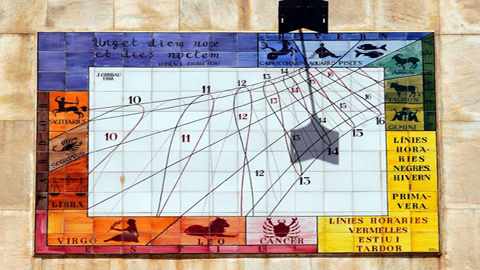Sundials, stars of a new exhibit

20/06/2014
Sundials were created by using skills in such diverse fields as astronomy, mathematics and art. They are basically made up of a stylet (called a gnomon), which is the element which produces the shadows, and the quadrant on which it casts its shadow.
The exhibit, which will be on display at the Library of Science and Technology, includes 11 sundial mock-ups, on loan to the UAB by Francesc Clarà (member of the Catalan Gnomonic Society) from his personal collection. All sundials were built taking into account the geographical situation of Olot, where Francesc Clarà lives (42 degrees, 10 minutes North, 2 degrees, 28 minutes East).
The exhibit explains what a sundial is and how it works with the help of texts by Joan Girbau, lecturer of the Department of Mathematics and expert in sundials. The library has prepared a special website on the subject called Rellotges de sol.
The theoretical part is complemented with the exhibit of 11 mock-ups, representing different types of sundials:
-Equatorial sundial: this is the most didactic sample. The hours are separated by 15 degrees. The gnomon faces the North Star and the dial is parallel to the Equator.
-Double equatorial-polar sundial
-Diffraction sundials: placed under the sun, the hours are marked by a line, but there is no shadow. To read the hours, the eye must be reflected in the mirror at the centre of the dial.
-Horizontal sundial with pierced gnomon: once it is correctly oriented, from North to South, the hours are marked by the sunrays passing through the gnomon's hole.
-Sun and moon armillary sundial: in order to correctly calculate the time it is necessary to know how many days remain before the next full moon because for each mistaken day there is a difference of 45 minutes. The sun's shadow at 12 noon marks the corresponding zodiac sign.
-The shepherd's dial: portable sundial. To tell time, the gnomon must be turned around the dial according to the position of the sun.
-Cylindrical helical sundial: the gnomon faces the N, towards the North Star, and marks the time with the shadow found on the inside of the cylinder.
-Conical helical sundial:
-Multi-gnomonic sundial: facing the North, each gnomon has its own shadow. The one marking the time at each moment is the one passing over the black ball which is located in the centre of the platform.
-Polyhedral sundial with 25 surfaces: it is a traditional sundial, with the gnomon always facing the North Star. In this case, all 25 gnomons are parallel to each other.
-Sundial with different time zones: mock-up containing seven sundials, according to the location of the following cities: London, Moscow, New York, Olot, Tokyo, Buenos Aires and Cairo.
The exhibit includes specialised books and journals, such as “La busca de paper”, edited by the Catalan Gnomonic Society, and other publications by international associations dedicated to the study of sundials.
THE UAB SUNDIAL
The sundial at the UAB is located on the façade of the Faculty of Science and Biosciences, and was placed there at the end of the 1980s. The sundial follows universal time, i.e. the official time minus one hour in winter and minus two hours in summer. It also indicates the zodiac sign and corresponding season of the year. It was designed with the plotter from the Calculation Centre of the UAB.
The particularity of the UAB's sundial is that what signals the time is not the shadow of a stalk but that of a point. When the shadow of this point falls outside of the dial's square, it does not mark the time. The traditional gnomon has been replaced by a metallic piece. The point which marks the hour is the shadow of the vertex. The hour lines are shaped in the form of an 8. The zodiac signs appear in Latin, together with an inscription by Horace: "Urgent diem nox et dies noctem" (Night follows day and day follows night).